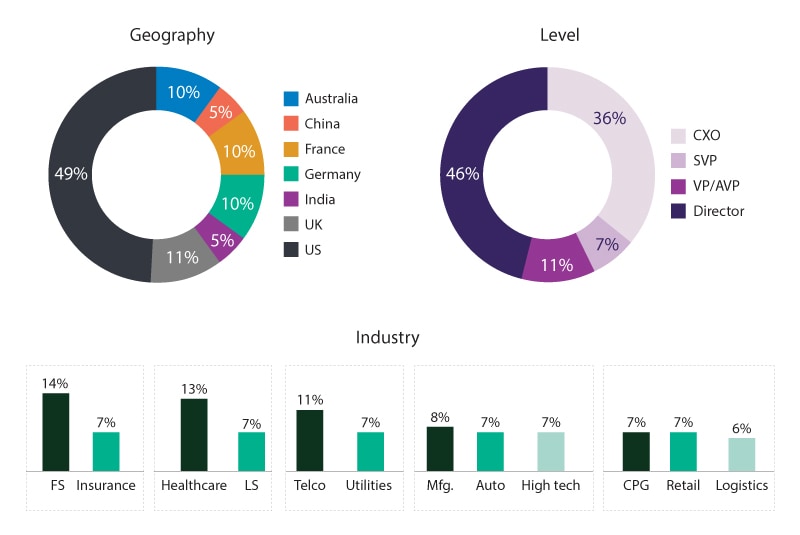The digital transformation journey
Retailers were early targets of digital disruption. But the consumer packaged goods industry, which fills those physical and digital shelves, initially avoided much of that upheaval.
Now traditional distribution networks and sales models are breaking down, while historic market data provides less insight and direction. Consumer tastes and new competition threaten the survival of an increasing number of recognized brands.
New online marketplaces, social media and consumer data provide both challenges and opportunities as the evolving market upends the old order.
How CPG companies navigate their digital future will determine whether those brands continue to thrive or become corporate footnotes.
In early 2018, Infosys surveyed more than 1,000 senior management-level executives working in large organizations around the world with more than 5,000 employees and over $1 billion in annual revenue. That research on digital evolution included responses from dozens of CPG industry executives.
Based on that survey, we produced a report — Infosys Survey Report — showing that incumbent organizations (as opposed to digital natives) fall into three clusters determined by their progress along the digital transformation journey:
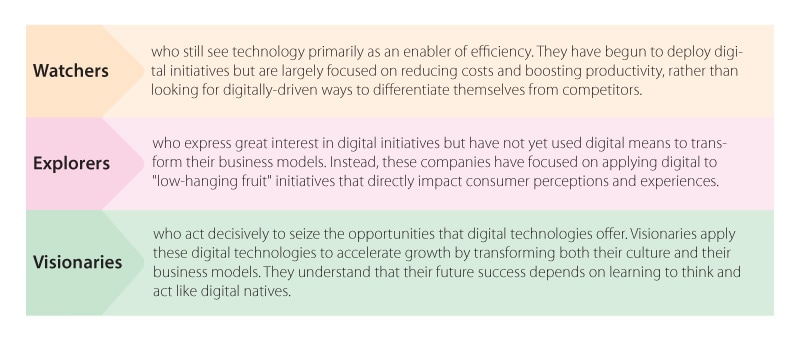
Knowing that many organizations are rapidly intensifying their digital transformation efforts, Infosys conducted a new survey in November 2018 to gauge the pace of that change. There were few changes in the survey results among CPG companies. There were slightly fewer watchers and visionaries, and slightly more explorers.
Among respondents in all industries, visionaries remained flat while watchers increased. Executives have generally found that companies can advance from the watcher to the explorer level without herculean effort, but reaching the visionary level is significantly more difficult.
Attaining visionary status is increasingly important for CPG companies in an era when brand names hold less sway over digital natives, barriers to entry have fallen and online sales drive growth.
Fewer watchers, more explorers
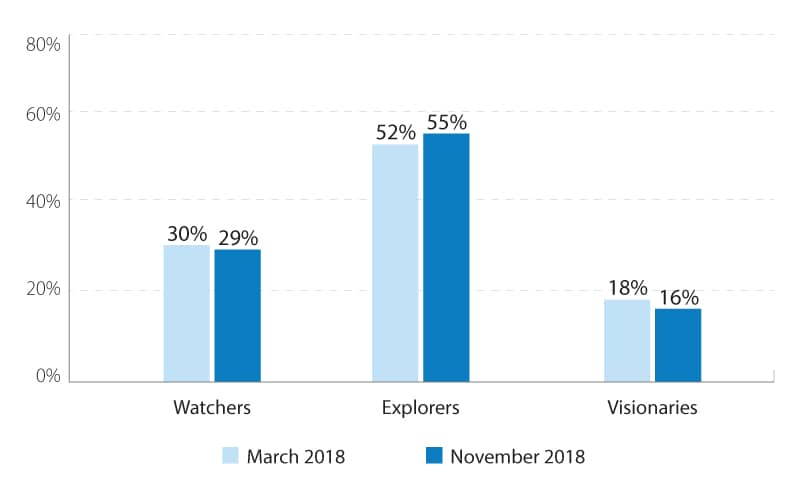
The need to be visionaries
Almost every incumbent CPG company is being pushed by disruptors or peers to transform, whether it’s battling for digital or physical shelf space, figuring out how to merge the online and store experiences or competing against a growing number of private label brands.
Many companies will survive only if they become digital transformation visionaries.
“Digital natives are growing fast and getting to billion-dollar valuations in record time,” pointed out Rohit Setia, executive director of IT at Estée Lauder. “We’re an explorer, but to survive, we need to become a visionary organization. It’s a struggle to get there.”
Some incumbents unable to keep up with the pace of technological change have already succumbed to competitive pressures. Many more in the CPG industry will likely fall by the wayside, similar to what has already happened in retail. To avoid being blindsided by competitors and stay relevant, companies must find ways to transform their products, processes and business models using digitally-enabled approaches and technologies.
Navigating the transformation journey
Our most recent study takes a closer look at the transformation journey. We identified 22 key digital initiatives and then asked respondents where their companies stood on implementing each initiative:
- Not started (or in planning).
- Completed multiple proofs of concept.
- Completed pilot projects.
- Operating at scale.
We then developed the Digital Maturity Index and assigned each company an index score from 0 to 100 according to its progress on pursuing and implementing the 22 key initiatives.
Companies on the digital journey
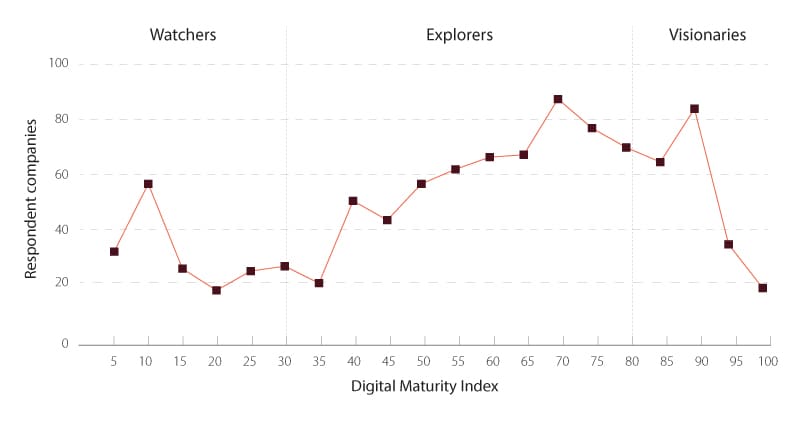
As CPG companies advance through the digital transformation journey from watchers to explorers to visionaries, they operate more and more key digital initiatives at scale. The types of projects change throughout the journey and can be grouped into four categories:
- Foundation initiatives must be implemented to modernize legacy systems.
- Mainstay initiatives represent the core elements of digital transformation, including automation and artificial intelligence (AI).
- Customer initiatives primarily impact the consumer experience. They include omnichannel marketing and content personalization.
- Forefront initiatives harness cutting-edge technologies, such as augmented reality (AR), drones and blockchain.
Visionaries stand out – cluster progress across 22 digital initiatives
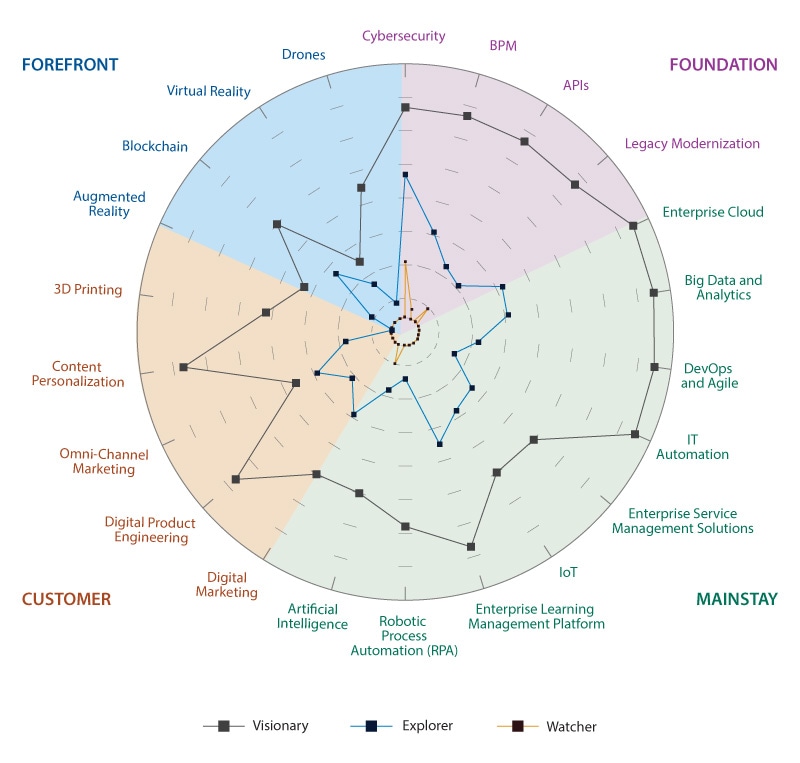
As shown in the previous figure, CPG visionaries are significantly more advanced than explorers in their implementation of virtually all initiatives, and watchers are far behind.
Watchers
- They typically operate at scale on only one or two digital initiatives, with perhaps a couple of others in the pilot testing phase.
- None in the CPG industry were operating at scale on the “internet of things,” robotic process automation (RPA), content personalization or any of the forefront initiatives. Ten percent had reached that level for AI.
- None have advanced beyond the planning stage on any forefront initiatives.
- Among the foundation initiatives, cybersecurity shows the most progress in CPG. Compliance and liability pressures are driving all companies in all clusters to invest here.
- CPG watchers are investing in Agile and DevOps, with success in pilots. However, our research indicates difficulty in converting these small wins to larger initiative success.
- Digital marketing is the leading customer initiative for watchers. This is seen as a leading indicator of customer-centric initiatives to follow, as CPG companies now interact with — and sometimes sell directly to — consumers.
Explorers
- Much further along than watchers, explorers have completed pilot projects for an average of seven key digital initiatives.
- They have progressed past the planning stage on four-fifths of the initiatives, yet they are operating at scale on only about six initiatives.
- Explorers are also showing progress in cybersecurity, as the leading area in foundation initiatives. CPG companies now have to worry about the possible theft of intellectual property as well as their growing collection of consumer data.
- Earlier investments in business intelligence have provided a foundation for big data and analytics, which is important for understanding what consumers want and why they want it. Explorers have made more progress here than on most mainstay initiatives.
- Explorers have also made as much progress on digital marketing as on any customer initiative. This rules-based, revenue-oriented initiative tends to provide a clear business case and also highlights the importance of growing sales in an environment of price pressure, increasing competition and a fragmented media landscape.
Visionaries
- Far ahead of their peers, on average they are at scale for 12 initiatives and have completed pilots on seven further initiatives.
- CPG visionaries have either completed pilots or achieved scale on nearly all key initiatives, with the exception of forefront projects. Nine percent are pursuing drone programs, while 17% are working on blockchain proofs of concept.
- The overall consistency of progress across initiatives is remarkable, and shows that a comprehensive approach is required to attain leadership. It also implies possible synergy across initiatives, where success in one area, such as big data, may provide core capabilities for another initiative, such as internet of things. For CPG companies, that technology has a range of benefits, including the creation of smart shelves and the ability to monitor supply chains.
- Even in the forefront category, where progress is understandably less advanced than in the others, there is still consistency across initiatives. From our discussions with industry executives and experts, this highlights a “lean forward” mindset that embraces the understanding that today’s advanced technologies will become a vital part of tomorrow’s operating system.
Changing focus, making progress
Visionaries have many more initiatives operating at scale
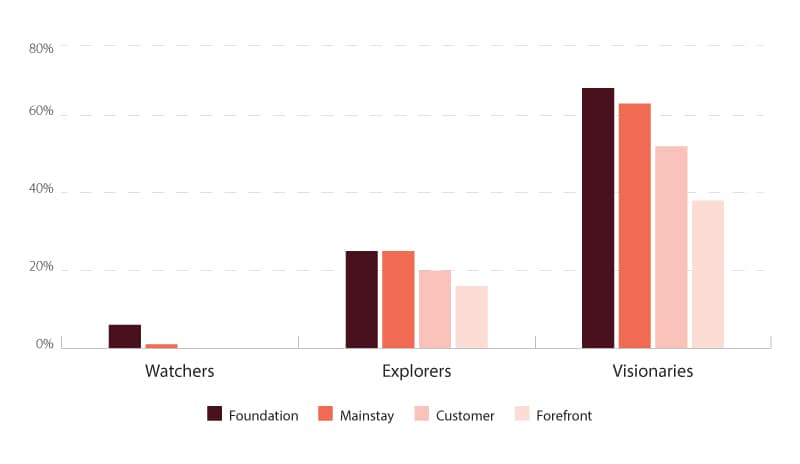
As CPG companies advance along their digital transformation journeys, they tend to focus on different sorts of projects. Watchers are just trying to build a foundation for their digital transformation, so they are unlikely to have the bandwidth to launch mainstay, customer or forefront initiatives.
As companies reach the explorer stage, they turn their attention to a broader range of initiatives including such mainstays as RPA, enterprise cloud, and big data and analytics, which is valuable for mining sales data for new insights or refining new product development and release processes. CPG firms can also spend time working on consumer initiatives such as content personalization, digital product engineering and digital marketing. However, explorers must still invest time focusing on the basics, such as scaling the implementation of core foundational initiatives such as legacy modernization, application programming interfaces (API) and business process management (BPM).
CPG visionaries bring many initiatives to scale within foundation, mainstay and customer categories. They are also the only cluster making substantial progress on scaling forefront initiatives such as 3D printing and blockchain technologies. Blockchain has the potential to improve consumer loyalty programs, fight counterfeiting, create new shopping platforms and enhance the supply chain.
Shifting barriers on the digital transformation journey
Our survey revealed that an inability to experiment quickly is one of the greatest barriers to digital transformation that CPG companies faced in 2018. More than half of respondents (53%) worry that their companies lack the capacity for rapid experimentation that is essential for testing different technologies and figuring out which ones hold the most promise.
Most companies believe that they can quickly develop this capability. Only 22% of respondents in the CPG industry felt that lack of rapid experimentation skills would still frustrate their digital transformation in 2019.
Barriers in the digital journey
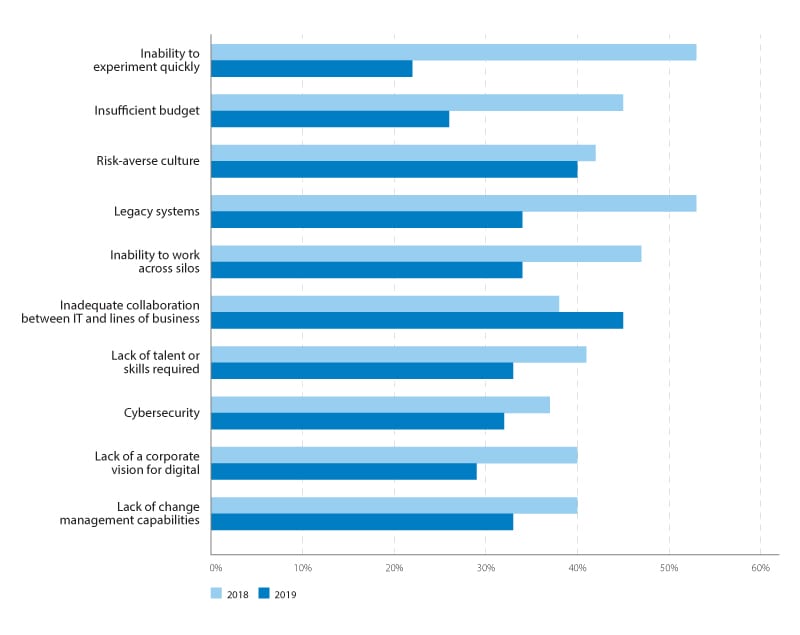
We believe that companies underestimate the challenge of mastering the art of rapid experimentation. Companies need to implement major cultural changes to become adept at rapid experimentation, according to Alok Uniyal, head of Agile and DevOps at Infosys. Significant cultural shifts rarely happen quickly, and usually not as quickly as changing consumer tastes.
While respondents feel that most barriers to digital transformation will diminish over time, they have persistent concerns over legacy systems.
Legacy systems currently rank as the fourth most commonly cited barrier (named by 41% of respondents), but participants in the CPG industry expect that such systems could become the most serious barrier in 2019.
Indeed, digital natives cite their lack of legacy systems as a major competitive advantage.
Experience with digital transformation is a double-edged sword. On the one hand, the visionaries who have progressed the furthest along the digital transformation journey recognize the most barriers, identifying more than four from the list of 10 that we provided.
At the same time, CPG visionaries are also more optimistic than their counterparts in the watcher and explorer groups about overcoming these barriers. This demonstrates that companies become more confident as they gain experience with implementing successful pilots and bringing ideas to scale on their digital transformation journeys.
Survey respondents are also confident that budgetary constraints will become less of a barrier in 2019.
While 45% of CPG executives cite “insufficient budget” as a barrier to digital transformation in 2018, only 26% feel that it will still be a serious stumbling block this year. If organizations were to invest more in key digital initiatives, it would show that senior leaders are strengthening their commitment to digital transformation.
Unlike participants in other industries, CPG executives expect that change management will get easier as time goes on. While 40% of respondents named “lack of change management capabilities” as a barrier in 2018, only 33% said it would be a problem in 2019.
Digital maturity by industry
Our survey revealed significant differences in digital maturity by industry. We found that CPG companies lag behind most others on their digital transformation journeys.
The biggest challenge faced by the CPG industry is an inability to work across silos.
Fifty-eight percent of visionaries from our research cited this result — an alarming finding for top-tier CPG firms. However, visionaries are far ahead of watchers in recognizing major business objectives for digital transformation such as enabling seamless consumer engagement and a transformative business culture.
Technology, manufacturing and telco were industry leaders, while Digital Maturity Index scores were distinctly lower in other industries such as logistics and health care.
Legacy incumbents are trying to make progress toward digital transformation, but often their efforts are hampered by regulations, security concerns and complex internal processes.
Industry ranking on the Digital Maturity Index
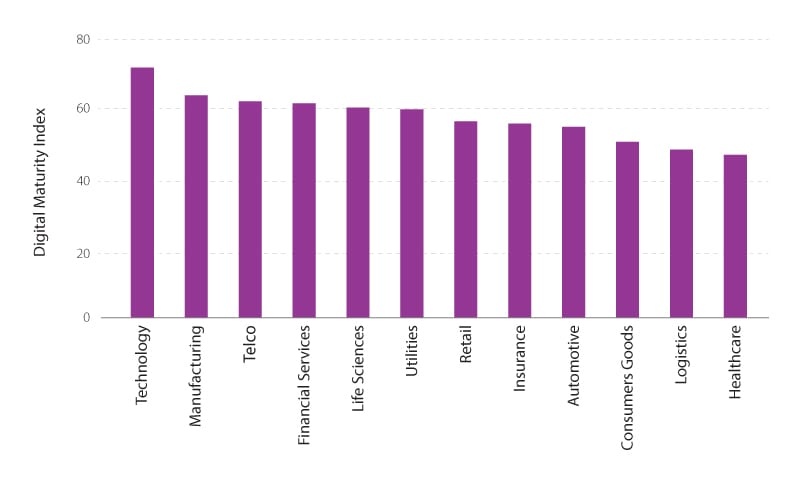
Accelerating the digital transformation journey: 5 key capabilities
In August 2018, Infosys conducted a research study that identified five capabilities that help companies, including those in the CPG industry, accelerate their digital transformation journeys: Agile and DevOps, automation and AI, design, learning, and proximity.
In our November 2018 executive survey, we looked deeper to understand company competencies in these areas. We found that companies with the highest Digital Maturity Index scores (i.e., visionaries) do indeed have the strongest abilities in all accelerator categories.
Visionary companies have superior accelerator capabilities
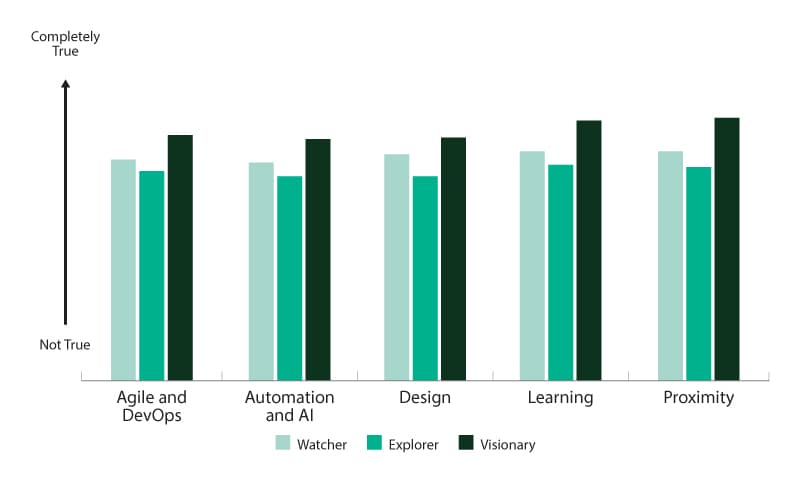
The five digital capability accelerators above are each powerful in their own right, and we examine each of them on the pages that follow. Before looking at the accelerators individually, it is worth reviewing them holistically at a summary level. When we reviewed client and industry digital transformation programs, we found multiple successes in the past two years where one of the accelerators was dominant.
However, in discussions with executives about the next 12 months and beyond, the consistent message was that multiple accelerators will increasingly be needed for future success. Agile and DevOps programs will be required for the uncertainty that accompanies the frenetic ongoing pace of change. The amplification and intelligence from automation and AI will be required to make sense of an increasingly complex world.
Design will become a non-negotiable expectation that goes beyond functionality to experience, and will permeate more and more business functions.
The rate of change faced by enterprises, and the necessity for widespread adoption, virtually guarantee that learning will be a core part of any lasting transformation. Finally, the location of or proximity to work will be a major factor in capability and program planning, for both strategic intent and cost management.
Let’s examine each of these digital capability accelerators.
Digital transformation accelerator No. 1: Agile and DevOps
“There’s an overarching need for companies to be nimble and responsive, to understand company needs and to quickly develop solutions,” said Uniyal, the Infosys Agile leader.
“Agile and DevOps enable companies to beat competitors by quickly experimenting, validating ideas and scaling leading-edge solutions. They enable greater flexibility and higher productivity. DevOps helps by automating the Agile software development life cycle, enabling companies to deploy new features on a nearly continuous basis.”
This is particularly useful in branded consumer goods where speed is critical. Incumbent companies must now keep pace with fast-changing trends and competitors that have greater access to manufacturers and supply chains.
In other industries, such as banking and airlines, there are regulations and risk and audit controls that can impede efforts to scale up Agile and DevOps. But the greater hurdles for CPG companies are internal, such as the risk to operational efficiency during the transition to Agile.
Perhaps even more significant hurdles are the monolithic ERP systems used by incumbent CPG companies. That inflexible legacy infrastructure makes it difficult to create new data-centric initiatives or create apps. Without significant investment in new systems, an Agile approach would likely struggle or even fail.
The visionary companies that are furthest along the digital transformation journey have the strongest ability to deliver Agile programs at scale. They have fully adopted both an agile mindset and Agile practices. Their IT developers and operations teams cooperate closely to achieve business objectives. Optimizing product life cycles must be a yardstick for watchers and explorers to benchmark and improve consumer loyalty in an industry that is hurt by logistical or distribution bottlenecks. DevOps can come to the rescue with intelligent data-driven orchestration to evolve with consumer demands in real-time.
Their technology teams deliver results fast enough for these legacy companies to stay competitive and fend off digital native rivals. Such visionaries are also likely to have a robust, stable DevOps platform that serves their entire enterprise.
There are two primary barriers that prevent CPG companies from making more progress on Agile and DevOps.
One major organizational challenge is changing the culture to ensure that business cooperates with IT from the start.
Our research has found that about 80% of development projects are IT-led and IT-sponsored, without early involvement of business stakeholders. IT infrastructures are legacy-based, and monolithic ERP systems are characteristic of the current CPG industry.
In addition to cultural change, CPG companies also need to make sure that their employees are trained in new ways of working. This retraining must extend throughout the organization so that all stakeholders have a good understanding of these new ways of working.
While our survey shows that many companies are confident — perhaps overconfident — in their ability to master rapid experimentation, the reality is that Agile and DevOps techniques are hard to master. Even companies that purport to have flexible, Agile teams may still rely on the same old structured, rigid waterfall development methods inside those teams.
There are practical steps that companies can take to improve their Agile and DevOps skills. Companies can work faster and scale quicker while meeting the demands of global markets by implementing Agile on a distributed basis.
“Companies need to become more dynamic and nimbler,” Uniyal said. “To react faster to changing markets and come up with improved products and services, companies need to have a culture of rapid experimentation, quick development, prototyping and validation. To accomplish this, they need to be able to visualize their end-to-end value chain. This is a major challenge in legacy organizations where the value chain may be fragmented. The best way to overcome this issue is by implementing Lean.”
Digital transformation accelerator No. 2: automation and AI

AI and automation have the potential to radically transform existing business models and unlock new opportunities in CPG. These technologies have become important tools to improve the supply chain and manufacturing efficiency, understand consumer behavior, measure trade promotions, and predict demand for new or existing products.
What distinguishes visionaries from their peers when it comes to AI and automation? Our survey found that visionaries are more likely to have developed and started to implement well-articulated strategies and initiatives for IT automation, RPA and AI. They also tend to approach automation and AI as ways to amplify human capabilities rather than just reduce headcount and costs. Their employees have the skills to implement automation and AI technologies in ways that advance corporate strategic goals.
Automation is crucial for CPG companies to optimize supply chain efficiency as new product cycles shorten. Delays pose a greater risk of failing to capitalize on changing consumer tastes and demand.
Consumer engagement and personalization are also critical areas where automation can move the financial needle. Shoppers are increasingly relying on online reviews to help them make buying choices and expect a wider range of choices.
AI and automation can lead to possibilities like Nike’s customized shoes, L’Oréal’s Facebook Messenger chatbot or Carlsberg’s AI analysis of beer flavors and aromas.
That said, companies at all stages of their digital transformation journeys are grappling with the ethical implications and opacity of AI, although that hasn’t been a prominent concern in the CPG industry.
“We need a paradigm shift in how we interact with AI and automation,” said John Gikopoulos, global head of AI and automation at Infosys. “We should apply ethics and control at the personal level, rather than expecting a process, machine or laws to govern these technologies once they are out in the world.”
Better tools are constantly coming to market that give companies new ways to create AI applications. Companies need to figure out the best ways to harness these tools to develop useful solutions that meet client needs. To get the most benefit from automation and AI, most incumbent companies will need to convince their own workforce about the benefits of these technologies and reskill employees to make sure that people and machines can work seamlessly together to achieve superior results.
A 2018 survey by the International Federation of Robotics offered a promising message.
About 70% of employees surveyed said automation and robotics would give them the opportunity to move to higher-skilled jobs.
Digital transformation accelerator No. 3: design
Design skills enable companies to rethink every aspect of their business, from internal operations to external customer service to the user experience. CPG companies with superior design skills use technology to find novel solutions to serve human needs, whether it’s design of internal processes or design of product packaging and consumer experience.
Our survey shows that companies with design strengths are better able to seize opportunities to improve both consumer and employee experiences.
One of the most prominent examples of design thinking was PepsiCo when CEO Indra Nooyi hired Mauro Porcini as the company’s first chief design officer. “They [consumers] don’t buy, actually, products anymore, they buy experiences that are meaningful to them, they buy solutions that are realistic, that transcend the product, that go beyond the product, and mostly they buy stories that need to be authentic,” Porcini told Fortune.
CPG industry visionaries understand that design must be broad based within an organization. Instead of segregating user design within its own silo, they make sure that more people, in more functions across the company, have responsibility to design products and services that maximize user satisfaction. Cross-channel user experience must be embedded into the strategy to find the right, consistent design for individualized engagement — building intuitive product recommendations with consistent messaging. “By 2020, smart personalization engines used to recognize consumer intent will enable digital businesses to increase their profits by up to 15%,” according to research firm Gartner.
Design-led CPG companies have effective processes in place to continuously listen to consumers. They are committed to testing ideas and iterating to make those ideas better over time. They measure design performance and results with the same rigor that they apply to tracking revenues and costs.
When it comes to pursuing design-led solutions, Infosys design executive Corey Glickman warned against excessive prototyping. He said too many companies spend millions of dollars a year on prototypes and proofs of concept, without ever moving on to implement those pilots at scale. In times of disruptive change, companies must bite the bullet and make big bets. It sometimes takes an industry leader or innovative upstart to establish a new norm. “No one would have a digital twin today if GE hadn’t sunk millions of dollars into developing theirs,” Glickman pointed out.
Systems engineering has emerged as a critical role in the digital age. The best systems designers are diligent scientists with master’s degrees and many years of work experience. This type of talent is in short supply, exacerbating the war for talent. However, the good news is that a systems designer with experience in one area can typically apply his or her knowledge to other domains. “Systems designers understand how large, complex systems behave,” Glickman said.
“As a discipline, systems design is universal enough that someone with experience in financial services can apply their skills and experience to software design or health care.”
On a practical, operational level, our research has confirmed the effectiveness of breaking up large projects into small teams of highly skilled programmers handling the hardest and most important challenges. These all-star coders are hands-on, working iteratively in physical and virtual whiteboard environments, efficiently pulling from reusable code libraries and writing their own fresh code every day.
This approach can reduce development time from three months to as little as three weeks. With this arrangement, companies can deliver more effective programming, solve difficult problems faster, and reduce technical debt that may have accumulated through legacy programming and processes.
Finally, the success of design-led digital transformations depends on the involvement of senior executives. Design is helping to transform major components of enterprise operating models, and success requires buy-in and leadership from the top.
Digital transformation accelerator No. 4: learning

Companies are facing a significant gap between the digital skill sets they need and the talent available, according to Jonquil Hackenberg, partner at Infosys Consulting. “Recent graduates, even in desirable fields like data science and enterprise architecture, lack the experience and expertise to implement at scale,” warned Hackenberg. “Meanwhile, many legacy IT professionals struggle to engage with subject matter experts in a way that translates business needs to modern, scalable technology solutions.”
Visionary CPG companies are more likely than other firms to bridge this talent gap by investing in the digital tools and infrastructure necessary to support a robust, always-on, continuous learning and reskilling program for employees.
Continuous learning is fundamental in order to develop the workforce of the future — one that can achieve and sustain digital transformation. Employees must become nimble, responsive and proactive enough to identify and seize the best opportunities made possible by emerging technologies and new business models. Our research findings suggest that such continuous learning programs play an especially important role in helping employees develop skills in Agile and DevOps, areas in which mindset shifts are as critical as technical skills.
The good news for enterprises is that self-directed learning programs such as LinkedIn Learning are delivering results and seeing employee adoption. “Employees used to expect training to be in person, that companies must send them to a physical instructor-led location to learn a new skill,” explained Setia at Estée Lauder.
“Now employees are willing, even enthusiastic, to self-train if you give them the tools. Employees appreciate the convenience of self-directed learning programs.”
Employees realize the critical importance of continuous learning to keep themselves marketable and relevant in a rapidly changing business world. Beyond internal skills development, learning programs have the added benefit of supporting retention.
Employees appreciate when companies make investments in their career development.
Many leading CPG companies have built their own internal training, reskilling and upskilling programs.
Our research shows that watchers often overlook the substantial benefits of learning accelerators.
For companies looking to make the move from watcher to explorer, investing in learning is an important early step.
Digital transformation accelerator No. 5: proximity
Even though many CPG companies are competing in a global marketplace and have access to a growing suite of collaboration and communication tools, distance still adds complications to any initiative or project. On the other hand, proximity enhances collaboration and can remove physical barriers to success in product and IT development projects.
“Value creation occurs when companies bring teams together end-to-end in proximity,” advised Deverre Lierman, leader of the Infosys Raleigh Technology Hub.
“Companies should deliberately structure their ecosystem and choose their partners with an eye to maximizing innovation, speed and responsiveness. The key is to capitalize on the benefits of high-quality, low-cost locations without sacrificing the advantages that proximity brings. Visionaries balance global delivery centers with nearby innovation hubs.”
These hubs may be internal or involve strategic partners.
Our data shows that visionaries are more likely than watchers or explorers to have implemented finely tuned strategies to locate employees together in geographies that balance cost with proximity to partners, often in the San Francisco Bay area (Levi Strauss, Johnson & Johnson and others).
Global CPG companies are embracing tech-driven innovations more than ever, as many of them collaborate with local partners to implement digital solutions, such as the Unilever Foundry with offices in eight countries or Coca-Cola’s lab at Georgia Tech University.
Procter & Gamble accelerated its transformation with a more than $100 million investment in a digital innovation center that incorporates local partnerships. Disruption of the traditional CPG supply chain also forces companies to become more dynamic and interconnected across the value chain as they cater to changing consumer attitudes.
Still, even visionaries in the CPG industry depend on the contributions and efficiency of distributed development teams. Visionaries supply these teams with effective collaboration tools and implement standards to measure the quality of work these distributed teams deliver. To the extent that visionaries rely on global development centers, they also invest in the infrastructure and systems to minimize the impact of distance.
At the same time, visionaries recognize that there is no substitute for physical proximity and are quite willing to establish well-staffed technology and innovation hubs near important partners or customers. That is why Infosys is establishing six new technology and innovation hubs in the United States and staffing them with 10,000 American employees to serve its customers there. Such proximity is especially valuable when working on initiatives involving customer experience, such as product development, content personalization and AR.
“When the business and IT leads work closely together, they can each see how important the project is to the other side,” said Estée Lauder’s Setia. “Projects work much better that way.”
Companies looking to reap maximum benefits from proximity should locate their technology and innovation hubs near end users (i.e., clients) and in places that have intrinsic appeal for the talent that the company wishes to recruit and retain. Locations near top universities are also attractive, since those schools can provide a pipeline of candidates for recruitment and an ecosystem for incubating innovation ideas.
CPG companies at all stages of digital transformation should strive to create a culture that attracts talent. Our research shows that employees want to work in a collaborative and collegial environment, where they know they can focus on getting results without wasting time fighting turf wars.
Practices and mindset — what sets visionaries apart
Every incumbent CPG company knows that it needs to make progress on its digital journey, but our recent survey indicates most are not moving fast enough.
How can they move to the visionary level? What sets visionaries apart from watchers and explorers?
According to our research, visionaries stand out in the way they have fully embraced the mindset and practices of both being agile and doing Agile.
To become more like visionaries, companies should put in place a formal digital transformation strategy, and share that plan with employees, customers and partners alike. They should also develop and implement a comprehensive strategy for using automation and AI to bolster human capabilities, rather than just focusing on cutting costs.
These are not trivial matters. Companies will face real challenges around talent recruitment and reskilling, retooling legacy systems, building the five accelerator capabilities, and fighting off lean, hungry digital native disruptors.
The truth is that incumbent CPG companies need to do three things, do them all well and do them simultaneously:
Establish the technical foundations for digital transformation.
Build technological capabilities and talent.
Innovate at the speed of Agile.
There are two ways that companies can give themselves a boost on the digital transformation path.
They can seek to amplify their existing capabilities by focusing on high-value projects with the greatest potential impact, and they can partner with other organizations to gain access to complementary skills and resources.
Amplify
Companies have limited talent resources, so it makes sense to focus systems designers’ efforts on the biggest problems, where the solutions they create will have the greatest impact. “You can amplify the impact of designers by assigning them to small teams where they can work together to deliver scalable solutions that can be replicated throughout the organization,” explained Infosys’ Glickman.
“If you have the right systems and process, a small number of talented individuals can have a big impact on a company’s digital transformation journey.”
Companies need to figure out which projects to prioritize and how to push the digital envelope where it will matter most. Visionaries are comfortable with different parts of the organization being at different steps in their digital transformation journeys.
Here’s a key insight — not everything needs to be Agile.
“Some scope and some projects take more time and care to get right, and this means waterfall in some cases,” said Setia at Estée Lauder.
Partner
CPG industry executives told us that one-third of digital initiatives are led and delivered internally, about half are led internally and delivered by partners, and the remaining one-fifth are fully delegated.
Companies partner for two-thirds of their digital initiatives
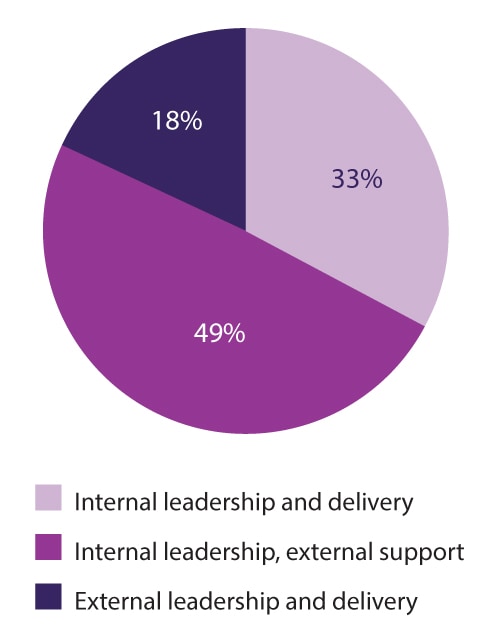
There is a significant difference in how clusters handle partnering. Overall, watchers are the most likely to run initiatives entirely internally, although that’s reversed in the CPG industry. Explorers are most likely to lead projects internally, while having them executed externally. In most industries, visionaries are more likely than the others to let partners run and deliver initiatives on their behalf.
Watchers are more likely to partner on digital initiatives
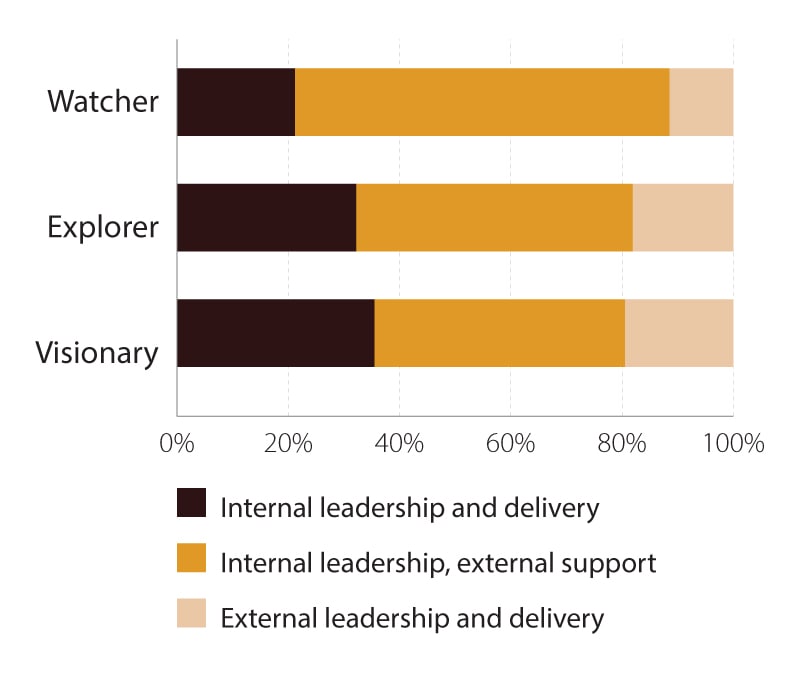
According to our respondents, partnering offers three primary advantages: higher chances of success, quicker implementation and skills transfer.
Partnerships have several advantages
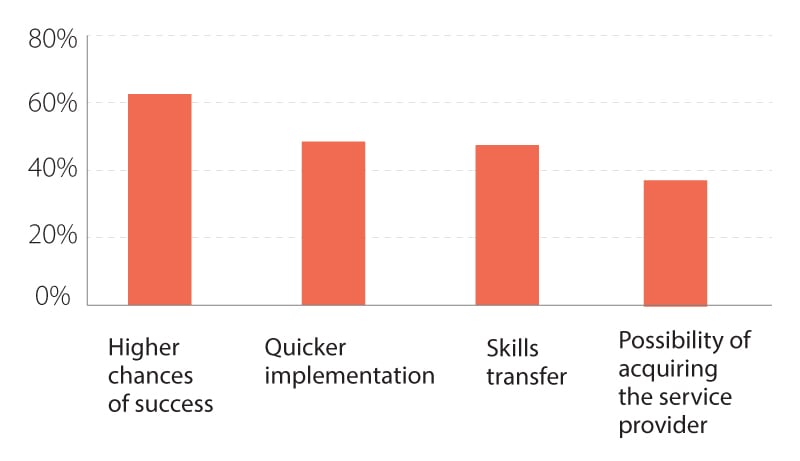
According to our research, visionaries are more likely to form partnerships because they have the process and governance maturity needed to build and run them effectively. It’s the same reason companies that invest in architecture and data management are more likely to support API interfaces with external services. Visionaries also have experience building partnerships and understand the multifaceted value of a good partnership, so they are more likely to pursue and forge additional partnerships when opportunities arise.
The digital accomplishments of visionaries also give them a better appreciation for the unique capabilities that partners bring to the table. When it comes to the vast world of technology, visionaries who develop certain technical skills also tend to learn that they cannot be experts at everything. Instead, they recognize the value of focusing on their core competencies and gaining access to other expertise through mutually beneficial partnerships.
Respondents told us the best partnerships are built on strong personal relationships among humans.
Our survey showed that CPG companies are willing to partner on almost any digital transformation initiative, but they are least likely to work with partners on legacy modernization, where they presumably feel they have the in-house knowledge to upgrade those systems on their own.
Survey participants reported that their companies were more likely to ask an external partner to both lead and deliver on sophisticated initiatives such as 3D printing, virtual reality (VR) and AR, which help consumers visualize products in new ways. About one-fourth of incumbent companies turn to partners for help with these sorts of initiatives that require specialized, hard-to-recruit expertise.
CPG companies were more apt to favor internal leadership while partnering with external help for execution on initiatives such as APIs, cybersecurity and BPM. These areas also require specialized expertise and significant resources, but in-house staff may already have some experience in these fields and thus feel more confident directing such projects themselves.
According to our research, U.S.-based companies tend to view intellectual property (IP) even more as a proprietary advantage than do their European and Asian counterparts. As a result, U.S.-based firms more often prefer to develop high-value innovation in-house. European firms partner for IP in a more transactional manner, while Asian companies have shown more openness for partners to take leading roles in IP creation.
Accelerating the journey
As mentioned in the Amplify section above, every CPG company — including visionaries — needs to prioritize specific digital transformation projects in order to maximize the impact of scarce resources.
How can a company know which projects to prioritize?
- Analyze its level of digital maturity and develop a clear, honest evaluation of current initiatives relative to objectives.
- Assess the short-term future of its industry. What are the key threats from disruptors? Which emerging technologies hold the most promise? How are consumer expectations changing? What impact will these factors have on business models?
- Ensure that the company has a solid digital foundation by modernizing legacy systems and working on APIs and BPM. Strength in these areas will enable success in other aspects of a digital transformation plan.
- Strengthen and refine the five accelerator capabilities: Agile and DevOps, automation and AI, design, learning, and proximity.
- Forge relationships with partners whose skills and services could promote faster, better progress toward digital transformation goals.
As with other change initiatives, senior CPG executives should take an active role in driving digital transformation initiatives. CPG industry leaders have to send a signal that internal power struggles will not be tolerated.
Digital transformation journeys can succeed only when individuals from multiple areas of the organization step outside their comfort zones and work across boundaries for the good of the entire enterprise.
This will significantly improve cross-functional operations in line with a strong corporate vision for digital, which is currently lacking even among visionary CPG firms. Zero distance supply chains, legacy system modernization and product innovation should be implemented at scale to embrace the agility and flexibility that this rapidly changing industry demands.
The digital future is arriving at a rapid pace, and the consequences of inaction are more severe than ever. With proper planning, cooperation and commitment, business leaders and IT professionals can work together to position their companies for success, no matter which direction the digital winds may blow.
Survey methodology
In November 2018, the Infosys Knowledge Institute used a blind format to conduct an online survey that attracted responses from more than 1,000 CXOs and other senior-level respondents from companies with revenue upward of $1 billion. Respondents represented multiple industries and hailed from Australia, China, France, Germany, India, the U.K. and the U.S.
To gain additional qualitative insights, we also conducted phone interviews with more than a dozen industry practitioners and subject matter experts.
